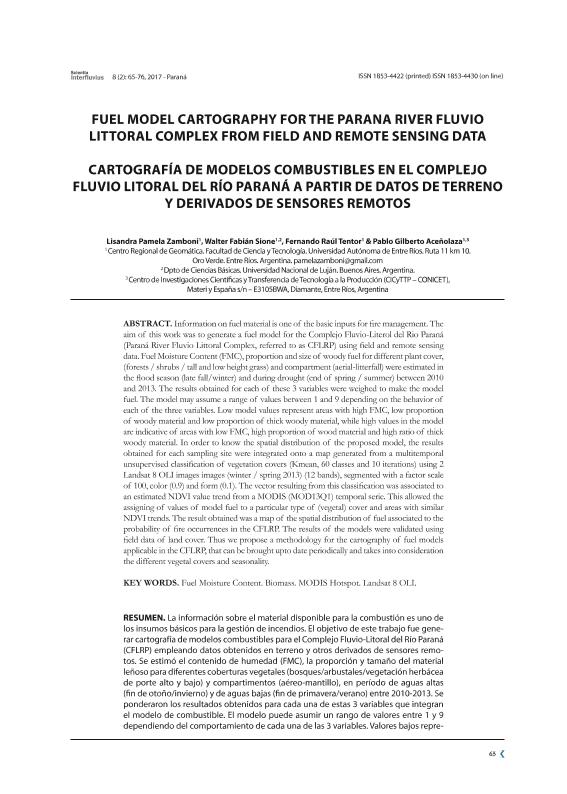Artículo
Information on fuel material is one of the basic inputs for fire management. The aim of this work was to generate a fuel model for the Complejo Fluvio-Literol del Rio Paraná (Paraná River Fluvio Littoral Complex, referred to as CFLRP) using field and remote sensing data. Fuel Moisture Content (FMC), proportion and size of woody fuel for different plant cover, (forests / shrubs / tall and low height grass) and compartment (aerial-litterfall) were estimated in the flood season (late fall/winter) and during drought (end of spring / summer) between 2010 and 2013. The results obtained for each of these 3 variables were weighed to make the model fuel. The model may assume a range of values between 1 and 9 depending on the behavior of each of the three variables. Low model values represent areas with high FMC, low proportion of woody material and low proportion of thick woody material, while high values in the model are indicative of areas with low FMC, high proportion of wood material and high ratio of thick woody material. In order to know the spatial distribution of the proposed model, the results obtained for each sampling site were integrated onto a map generated from a multitemporal unsupervised classification of vegetation covers (Kmean, 60 classes and 10 iterations) using 2 Landsat 8 OLI images images (winter / spring 2013) (12 bands), segmented with a factor scale of 100, color (0.9) and form (0.1). The vector resulting from this classification was associated to an estimated NDVI value trend from a MODIS (MOD13Q1) temporal serie. This allowed the assigning of values of model fuel to a particular type of (vegetal) cover and areas with similar NDVI trends. The result obtained was a map of the spatial distribution of fuel associated to the probability of fire occurrences in the CFLRP. The results of the models were validated using field data of land cover. Thus we propose a methodology for the cartography of fuel models applicable in the CFLRP, that can be brought upto date periodically and takes into consideration the different vegetal covers and seasonality. La información sobre el material disponible para la combustión es uno de los insumos básicos para la gestión de incendios. El objetivo de este trabajo fue generar cartografía de modelos combustibles para el Complejo Fluvio-Litoral del Río Paraná (CFLRP) empleando datos obtenidos en terreno y otros derivados de sensores remotos. Se estimó el contenido de humedad (FMC), la proporción y tamaño del material leñoso para diferentes coberturas vegetales (bosques/arbustales/vegetación herbácea de porte alto y bajo) y compartimentos (aéreo-mantillo), en período de aguas altas (fin de otoño/invierno) y de aguas bajas (fin de primavera/verano) entre 2010-2013. Se ponderaron los resultados obtenidos para cada una de estas 3 variables que integran el modelo de combustible. El modelo puede asumir un rango de valores entre 1 y 9 dependiendo del comportamiento de cada una de las 3 variables. Valores bajos representan áreas con alto FMC, baja proporción de material leñoso y baja proporción de material leñoso grueso), mientras que valores altos son indicadores de áreas con bajo FMC, alta proporción de material leñoso y alta proporción de material leñoso grueso. Con el fin de conocer la distribución espacial de los modelos combustibles propuestos, se integraron los resultados obtenidos para cada sitio de muestreo a un mapa generado a partir de cartografía de cobertura de vegetación resultante de una clasificación no supervisada (Kmean 60 clases y 10 iteraciones) de un compuesto (12 bandas) multitemporal de imágenes Landsat 8 OLI (invierno/primavera de 2013) segmentada con un factor de escala de 100, color (0.9) y forma (0.1). Al producto vectorial resultante de la clasificación se le asoció un valor de tendencia de NDVI estimada a partir de una serie temporal de imágenes MODIS (MOD13Q1). Esto permitió asignar los valores del modelo de combustible a un tipo determinado de cobertura y a su vez a aquellas zonas con similar tendencia de NDVI. Como resultado se obtuvo un mapa de la distribución espacial del combustible asociado a la probabilidad de ocurrencia de incendios en el CFLRP. Para validar el modelo se analizó la correspondencia entre los modelos y datos de terreno sobre cobertura del suelo. Se cuenta con una metodología para la cartografía de modelos combustibles aplicables CFLRP que puede ser actualizada de manera periódica y considera las diferentes coberturas vegetales y su estacionalidad.
Fuel Model Cartography for the Paraná River Fluvio Littoral Complex from Field and Remote Sensing Data
Título:
Cartografía de modelos combustibles en el complejo fluvio Litoral del río Paraná a partir de datos de terreno y derivados de sensores remotos
Fecha de publicación:
12/2017
Editorial:
Scientia Interfluvius
Revista:
Scientia Interfluvius
ISSN:
1853-4422
e-ISSN:
1853-4430
Idioma:
Inglés
Tipo de recurso:
Artículo publicado
Clasificación temática:
Resumen
Archivos asociados
Licencia
Identificadores
Colecciones
Articulos(CICYTTP)
Articulos de CENTRO DE INV.CIENT.Y TRANSFERENCIA TEC A LA PROD
Articulos de CENTRO DE INV.CIENT.Y TRANSFERENCIA TEC A LA PROD
Citación
Zamboni, Lisandra Pamela; Sione, Walter Fabian; Tentor, Fernando Raul; Aceñolaza, Pablo Gilberto; Fuel Model Cartography for the Paraná River Fluvio Littoral Complex from Field and Remote Sensing Data; Scientia Interfluvius; Scientia Interfluvius; 8; 2; 12-2017; 65-76
Compartir




